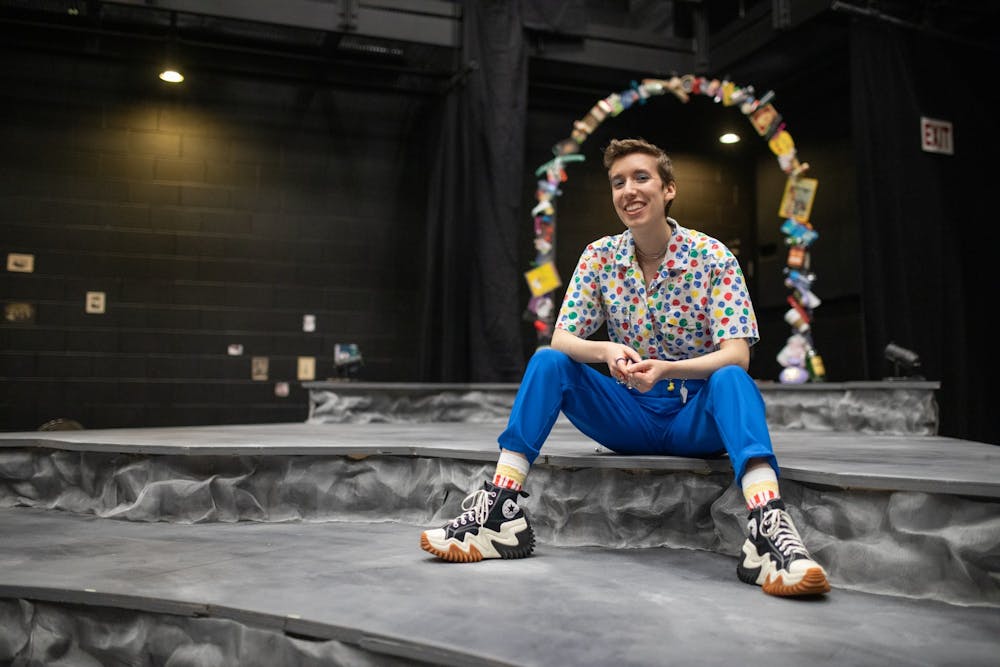Audience members found themselves transported into the otherworldly and unusual cavern of Sarah Ruhl’s “Eurydice” as they entered the Center for the Arts (CFA)’s Black Box Theater this past weekend.
A gigantic gray staircase split the space down the middle. Sculptures of garbage stood guard in the corners. Old family photos were plastered on the theater’s walls, and UFO-like rings hung from the ceiling. These unconventional elements transformed the Black Box into a bizarre liminal space where nostalgia and peculiarity reign supreme.
The mastermind behind this freakishly brilliant fever dream is set designer and senior theatre major E Lyons. The opportunity to bring the underworld of “Eurydice” to life enabled them to live out childhood dreams and adult aspirations.
“As a child, one of the jobs I wanted to have when I grew up was to be an architect, and I think this is the fruity version of that,” Lyons said.
The set was certainly eccentric, transcending the boundaries of the theater’s small stage. Lyons’ approach to the afterlife — candy-colored, artificial and surreal — was nothing like most depictions in pop culture. Lyons’ inventive set pieces, constructed from piles of found objects and discarded trash, serve as touchstones into the world of the discarded and departed.
The set creates a parallel between the afterlives of people and the debris they produce. Lyons calls it a “recycling center of sorts” — for objects and people alike.
“Objects, when they are discarded, do not quite retain their original function — they become something else,” Lyons explained. “But that something is not completely broken down into nothing. They still retain their resemblance, though they have lost their function, and that is one of the things exactly that happens to the living characters who die in this play.”
The cavern’s stalagmites weren’t rock at all, but instead the byproducts of human wastefulness that have gathered themselves into sculptures. Teddy bears, soda cans, typewriters, vinyl records and other miscellaneous knick-knacks made up the compositions of these eye-catching art installations.
“It’s like s—t for lack of a better word,” Lyons said. “It’s the remnants, it’s what got left behind. So that to me was the detritus of celebration, the detritus of childhood and of girlhood. And those qualities helped me come to the notion that found objects were going to be central to the set.”
The Black Box walls were lined with sentimental old photographs, many sun-damaged and faded. These photos, donated by members of the theatre department, constituted what Lyons dubbed the “memory gallery.” The deeply personal collection of treasured moments and departed loved ones acted in stark contrast to the rest of the set, which was filled with carelessly discarded ephemera.
“We have this dynamic of the dead watching the living, watching the living die,” Lyons said. “Which is sort of, I mean — colloquially, I would say mind f—ky. It sort of speaks to… the ways that the play can be convoluted at times in its magic.”
It served as an apt backdrop for the play, which deals with themes of loss and mourning through the lens of both the living and their departed counterparts.
“I believe that you cannot design this play without keeping grief and the sort of gestures and textures associated with that central,” Lyons said.
The most in-your-face element of the set was the imposing staircase that divided the entire theater, dominating the space entirely. This staircase, representing a mountain affectionately nicknamed “the strata,” was, at first, confounding.
“Why the f—k is it here?” Lyons asked, anticipating a common question viewers would have.
The “strata” indicated both Lyons’ desire to create the longest possible diagonal line in the Black Box and also represented the characters’ journeys through life, death and beyond.
As the characters embarked on their own journeys of loss, grief and finding life in death, Lyons had gone on their own journey to create a set that was unexpected, alive and meaningful to the narrative being crafted both during showtime and backstage.
Without Lyons and their collaborators, “Eurydice’s” underworld of magic, tragedy and lost love would’ve been lifeless — much like Eurydice herself after a fatal fall on her wedding day.
“Design work matters in ways I can’t even articulate,” Lyons concluded.
Meret Kelsey is the senior arts editor and can be reached at meret.kelsey@ubspectrum.com
Alex Novak is an arts editor and can be reached at alex.novak@ubspectrum.com
Meret Kelsey is an assistant arts editor at The Spectrum.
Alex Novak is a senior arts editor at The Spectrum.





